#LITERATURE REVIEW
Text

Franz Kafka
#franz kafka#kafka#classic#dark academia#writing#dark academia aesthetic#literature#art of writing#books#classic books#booklr#readers#life quotes#quote#book quotes#quoteoftheday#life quote#bookworm#dark academia writing#dark academia moodboard#dark aesthetic#aesthetic#light academia#germany#literature review
72 notes
·
View notes
Text

"what more terrifying revelation can there be than that it is the present moment?"
📚finally finished Orlando by Virginia Woolf!!📚
my first book by her and I really liked it! I gave it 4 stars⭐️⭐️⭐️⭐️
the prose is incredibly rich, which can be difficult to read at times honestly, and the story of Orlando's life was really interesting
I read this for uni to write an essay on it and there are so many interesting bits in it that would be amazing to analyse!!! I'm so happy to be excited ablout a research project again🙂↕️
this modernist fictional biography is very queer and if you don't mind the dense prose and some cultural insensitivity (cause it's from the 1920s) I would really recommend this!
#orlando#virginia woolf#orlando a biography#english literature#literature#literature review#book review#dark academia#dark acadamia aesthetic#dark academia vibes#grey academia#light academia#romantic academia#studyblr#aesthetic#booklr#bookworm#book aesthetic#books#bookblr#book quotes#reading#books and reading#book blog#modernism#modernist literature#women writers#woolf#my pics#my post
21 notes
·
View notes
Text

06.10.2023—running on pure grit and determination right now
#studyblr#studyspo#study notes#study motivation#bullet journal#study blog#athenastudying#stationery#studying#study#heygen#thesis#literature review#writing#essays#heyoka#heyacademic#heyartkid#heyargo#heyfox#lookdodia#heyxmissxjude#heyvenustudy#heybirb#heycoral#heychenleyah#dark academia#productivity#college#indie
56 notes
·
View notes
Text
An Ajin Manga Review: Discussing the Art
Part 1: Art Style in Relation to Storytelling
I entered this manga not knowing the first thing about it. I was scrolling through Manga4life after catching up on Hunter x Hunter and came across Ajin on the highest rated filter. I read through the comments and saw the praises for the story. I was collecting a number of different titles to read through and chose Ajin to begin my series of readings.
Why did I choose Ajin as a starter? What stood out to me about Ajin was its art. For many mangaka, the art begins somewhat immature and the artist hones their skills throughout the serialization. For example, there's a noticeable change in Tokyo Ghoul, Bleach, Naruto, HxH, etc. Ajin began with a recognizably polished art style thanks to Gamon Sakurai. The lines were confident and the scenes were already challenging in a way a veteran artist might be expected to execute. I was grabbed immediately!


These two pages are both from the first chapter. Note the details on the folds of clothes, the sneakers, the officer's ear, and his uniform even. I have not come across many manga who's art begins with dramatic detail in the most mundane things such as clothing, at least not in such a way. I'm reminded of how in sports manga, the mangakas take a lot of time to detail a player's shoes, because those have importance to the sport itself.
To clarify, Ajin still went through a maturity in its art. Obviously, there was a change when the original writer Tsuina Miura left. With Sakurai having more control over the story, it's clear his change in story affected the characters and art style as well. For example, Kei Nagai goes from a rounder more doe-like appearance to sharper and straighter lines. His original design fit alongside his character portrayal as an innocent kid unfit for the severity of the story's premise; Kei was perhaps meant to be pitied in the original story.

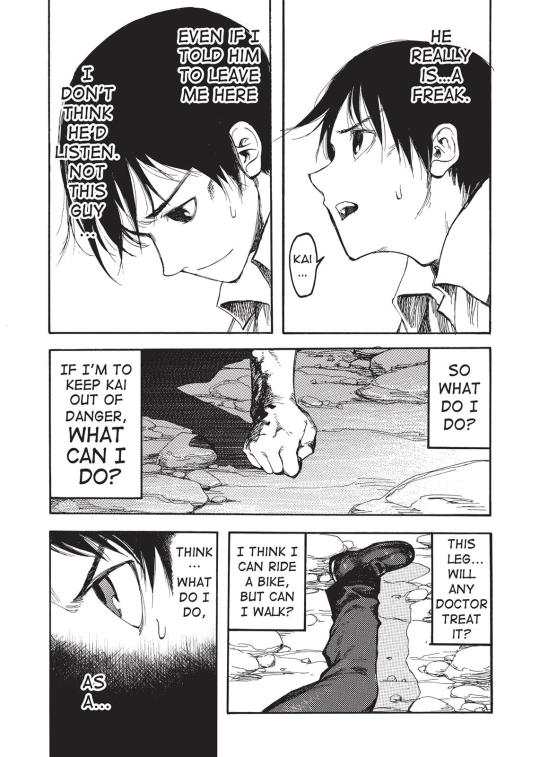
After Sakurai became the writer, Kei changed into an untrustworthy character who could shift personalities, utilizing both the younger look of the first volume, and the more confident and mature appearance Sakurai had created. Sakurai says that after volume 1, he "tried to move the art gradually closer to [his] own style" (ch.83, pg. 82). I recognize Kei's purposeful tonal changes as a creative method to transition the manga into Sakurai's own style and design changes that he had decided for the story.
Below, this series of pages illustrate first the differences between Kei in volume one and two. Then, the ways Sakurai uses both the softer and sharper designs to convey a transition of his character.
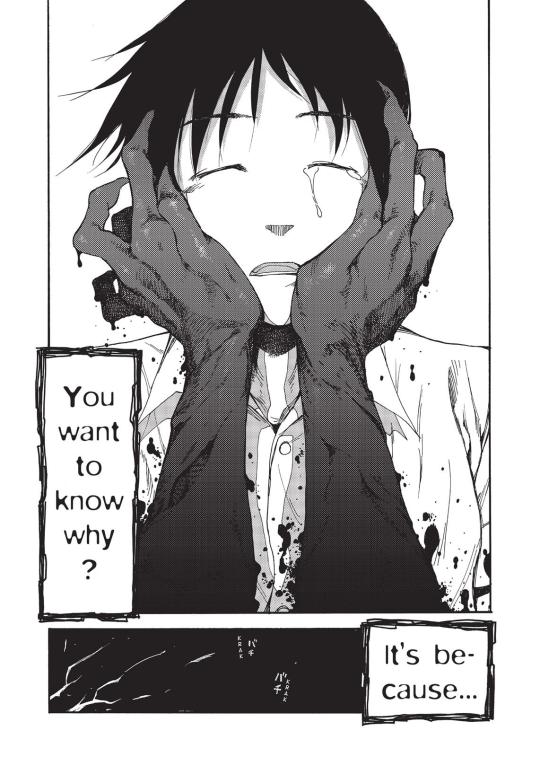

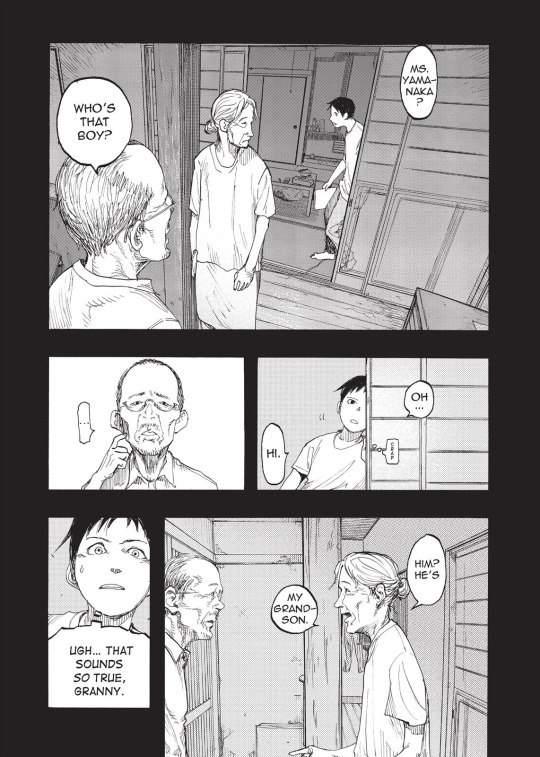
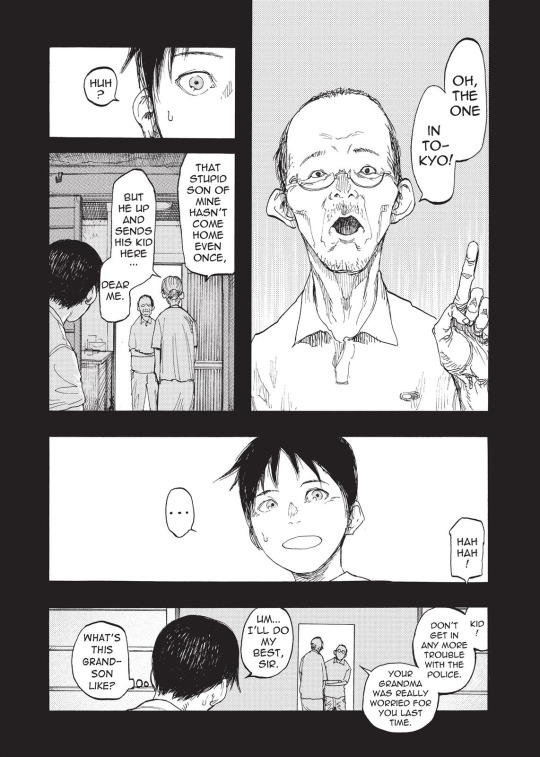
Finally, in chapter seventeen, page seven, Sakurai commits to the shift and reveals this new design and characterization to be the "real" Kei all along. Nakano comes to the same realization as the reader.
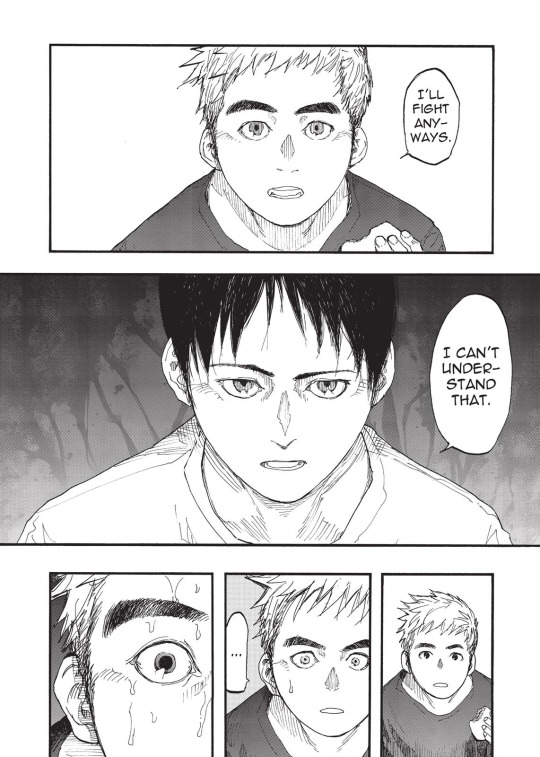
Sakurai used Kei's earlier more pitiful appearance to show Kei's softer mask that he wore to hide his true, more cold and calculative nature. After the moment between Nakano and Kei, the later design remains more consistent and total. Personally, I enjoy the later design more than the first and what it implied for the story. Along with a change in Kei's character was a change to the story's tone as well. Sato became more devious, and so did Kei. These character changes, in a way, foreshadowed the extremes in which the plot would take as well.
Though, still I would have enjoyed the closer relationship that was foreshadowed for Kei and Kai. I mean, look at these pages and tell me you don't see a budding homoerotic romance on the rise!
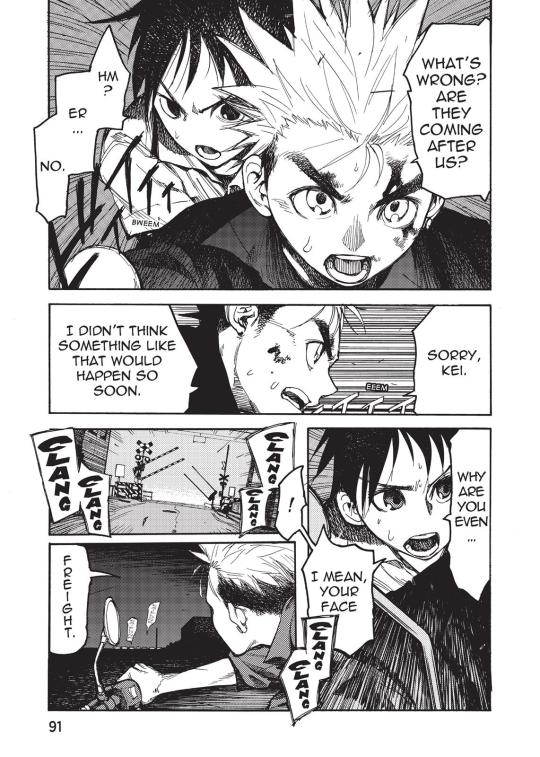

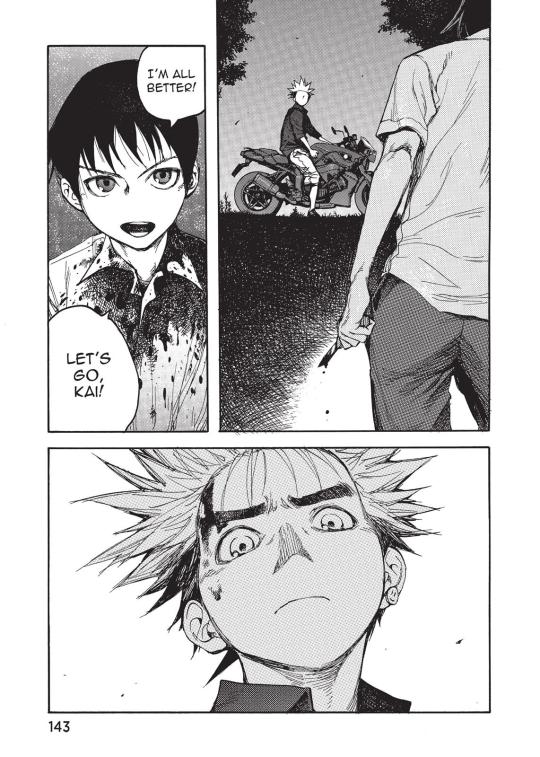
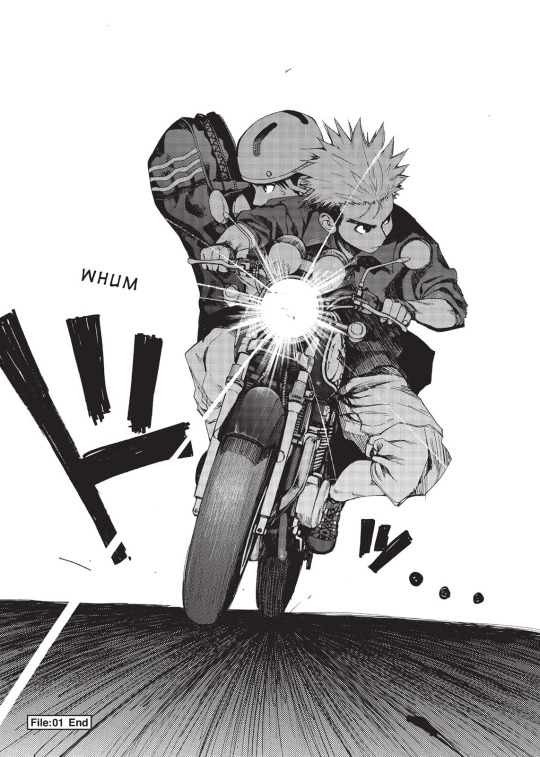
To round out my thoughts, I enjoyed the first premise, but overall enjoyed the second premise even more. In the next review, I'll dissect Sato's character and how he was handled from an authorial point of view. I just needed to discuss the art style change and what it implied for the story, especially Kei, as he plays an important role for the overall tone of the story.
#ajin#ajin demi human#ajin manga#manga#ajin review#manga review#literature review#book review#review#okay yeah#I should make this a youtube video
35 notes
·
View notes
Text





By: JLCederblom
Published: Apr 30, 2024
One of the most basic errors you would expect to be caught in peer-reviewed academic literature is plain data errors. They require no real expertise to catch and tend to be trivial to fix. It’s simply part of regular proof reading that any serious article of any sort should undergo.
So why are papers on transition regret rife with ridiculous errors, such as inventing thousands of people out of thin air? And why do those errors occur in the first place?
Let’s have a look at the latest in a long line of peer-reviewed garbage: “A Systematic Review of Patient Regret After Surgery- A Common Phenomenon in Many Specialties but Rare Within Gender-Affirmation Surgery” by Thornton et al.
This piece self-identifies as a systematic review, which it simply isn’t, but that’s rather technical (and, dare I say, academic) compared to the grievous errors in the paper, and will require some back-and-forth with the journal. Going over all of that in detail will take time and isn’t that interesting — although if the paper does get corrected or retracted, it’ll likely be due to such procedural issues rather than overarching problems.
While many individuals report satisfaction and improved measures of mental health after undergoing gender affirming surgery, there is a small but vocal minority who experience regret after their procedures.⁴
De-transitioning, also known as continued gender transition, has been exhaustively covered in the mainstream and conservative media and is an emerging area of study in gender affirming care.
The paper also has a rather noticeable disdain for the subject matter and a clear agenda with the goal of minimizing transition regret as a niche, “exhaustively covered” issue, championed by a “small” but unnecessarily “vocal” group.
Let’s have a look at the sources the paper cites for the rate of regret.
* * *
First up: Wiepjes et al., 2018.
A study performed in Amsterdam retrospectively examined 6,793 patients who attended a gender identity clinic in Amsterdam from 1972 to 2015 and found 0.6% and 0.3% of transwomen and transmen reported experiencing regret after gender affirming surgery, respectively. The authors noted that reasons for regret could be divided into three categories. True regret was defined as regretting having GAS. Social regret involved losing touch with loved ones or being fired from a job because of GAS. Lastly, some participants reported feeling non-binary and no longer feeling satisfied with their surgical result. Average time to experiencing regret was 130 months (more than 10 years) post-operatively.³⁰
This is simply erroneous. The authors make the claim that Wiepjes et al., 2018, measured reports of “experiencing regret after gender affirming surgery”. This is false, as the study first required hormonal detransition, the cessation of cross-sex hormone treatment and going back on your natal sex hormones, at the same clinic. Every time the authors describe this as only measuring “experienced regret” they are not being truthful.
In addition, the number who were investigated for this rather specific definition of regret was not 6,793 but 2,627. I’m not sure what the exact purpose of putting the number of people who visited the clinic, including those who never transitioned whatsoever, is but it certainly inflates the number.
You might ask yourself how it’s possible that the authors read Wiepjes et al., 2018, but did not manage to understand what was investigated, nor how many people were looked at. The most likely answer, to me at least, is that none of the authors, peer reviewers, or editors, actually read the paper.
* * *
Next up: Bustos et al., 2021. If you need a primer on this, I’ve written about it before.
In 2021, a systematic review and meta-analysis was completed which assessed 27 studies, including a total of 7,928 transgender individuals. One third of the included individuals underwent transmasculine procedures, while the remaining two thirds underwent transfeminine procedures. Of the 7,928 individuals included in the analysis, 1.0% expressed regret. The most common reason for post-operative regret was “difficulty/dissatisfaction in life with the new gender role.” Another common reason was failure of surgery to achieve their aesthetic surgical goals. The authors hypothesized that the rate of regret established by this metanalysis was lower than a previously established rate from 1993 due to increased rigor in the selection process before gender affirming surgery.
Bustos et al., 2021, pulls together all the greatest hits of gender pseudoscience: erroneous data, fraudulent methods, zero peer-review, irresponsibility (or perhaps hostility) from the journal, and more. It’s a paper where the factual error count is in the triple digits to this day.
However, after wrangling the arms of the journal editors a bit, they put out a partial correction (where they actually introduced some new errors as well as fixed a handful). The lowest possible bar you could hold the authors against in this 2024 paper is that they used that 2022 “correction.”
Of course they didn��t.
An inability to even copy and paste numbers is what we’re dealing with here. From the entire chain, authors through editors. It ties into the previous paper as well—if Thornton et al. had read Wiepjes et al., 2018, they would be entirely equipped to see through Bustos et al., which makes the exact same nonsensical mistakes they did.
I would provide an exact number instead of 7,928 here, but it’s not actually possible to do that because one of the included papers reports contradictory numbers, which Bustos et al. didn’t mention or, more likely, even notice. Another provides an estimate rather than exact figures. They also included papers which did not investigate a regret rate in the review, which is just bizarre.
Either way, out of the claimed 7,928 people, at least 3,400 were not investigated for regret in any way. As previously mentioned another 2,627 had a requirement that you had to hormonally detransition in order to count as regretful. Another didn’t measure regret at all, simply legal sex marker reversals. If you go through the papers and add up the number of people who were explicitly asked about regrets (in any way) you get around 1,300. With unknown loss to follow-up, often very short follow-up, and no uniformity to the way they were asked.
Which apparently to Thornton et al., the peer-reviewers, and the journal editors, is enough to conclusively state that we know the rate of transition regret.
* * *
Next up is Narayan et al., 2021, which was a combined survey and systematic review. See if you can spot the sleight of hand.
Another study surveyed all surgeons registered for the 2016 World Professional Association for Transgender Health and the 2017 US Professional Association for Transgender Health. Most respondents practiced in the United States and had surgically treated at least 100 transgender or gender-nonconforming patients. Of the 30% of surgeons that completed the survey, 61% respondents had treated at least one patient who experienced regret or requested reversal of a procedure. Overall, the calculated rate of regret after gender affirming surgery was 0.2%-0.3%. Of the 62 patients that respondents reported had sought reversal surgery, reasons for reversal included surgical complications, continued evolution of their gender identity, rejection or alienation from social support, and difficulty in romantic relationships.⁵
An anonymous survey of WPATH or USPATH conference attendants with 70 percent non-respondents (fairly catastrophic given the population), asking them to estimate the number of patients they’ve surgically transitioned (somewhere between 18,125 and 27,325) and how many patients they’ve “encountered” (meaning what?) who “regretted their gender transition” (open for a wide range of interpretations) is not a very serious approach.
The paper sometimes treats “regret,” “reversal request,” and “detransition” as the same thing, sometimes not. The authors (both Narayan et al. and Thornton et al.) seem very confused about what the respondents were actually talking about. Usually, when you’re confused, the right thing to do is to slow down and work it out. Not to take the decision to treat 62 patients seeking surgical reversal as “the regret rate”—which is absurd, and reveals the authors’ intellectual, or rather emotional, bias towards presenting as low a number as possible.
* * *
Next up is Bruce et al., 2023.
Recently, research from the University of Michigan demonstrated low levels of regret after gender-affirming mastectomy in a cross-sectional study. On average, respondents underwent surgery 3.6 years before the survey. The median Decision Regret Scale score was 0.0. Further, of the 139 respondents, zero requested reversal procedures.³²
The respondents certainly reported low decision regret. Of course, 3.6 year mean follow-up is less than most studies put the average time to regret at, and a 40 percent non-response rate is… an issue. It’s also exclusively following mastectomy, and that this often provides (at least) short term relief from breast-related distress seem highly plausible.
If Thornton et al. was a systematic review rather than a literature review with a (very poor) systematic search, these issues would be explored and Bruce et al. would take its rightful place as low quality evidence for potential short term benefits. Presenting it as evidence of a low regret rate, however, is ridiculous.
On a side note, Bruce et al. also cites erroneous data from Bustos et al., this time regarding follow-up times rather than sample sizes. It truly is the gift that keeps giving in terms of academic misinformation.
* * *
The final thing referenced is the 2022 USTS Early Insight report.
In February 2024, the 2022 US Transgender Survey Early Insight report was published, providing data from 92,329 binary and nonbinary transgender people. This report noted that 97% of respondents who had undergone gender-affirming surgery reported that they were “a lot more satisfied” or “a little more satisfied” with their lives.³³
This was an anonymous online survey recruiting participants via advocacy groups, and described as “a survey for trans people, by trans people.”
When Thornton et al. describe it as “92,329 binary and nonbinary transgender people” they actually get that wrong as well, as the report describes it as “38% nonbinary, 35% transgender women, 25% transgender men, and 2% crossdressers.” This may seem like nitpicking, but it actually describes the inconsistencies of the worldview that Thornton et al. champion.
Other than poking fun at them, there isn’t much more to say here. The Early Insight report doesn’t discuss regret, which is why they didn’t claim it did. Which would make it odd that they put it under the heading “Regret After Gender-Affirming Surgery” if you’re operating under the assumption that Thornton et al. are writing an academic paper, but that’s clearly not the intention.
* * *
Human writing has many purposes. The most obvious is communication, to convey thoughts and ideas to others. But we also do it for fun, or to assist ourselves, to organize our thoughts, all sorts of ways. Academic papers of this sort, however, are supposed to have a single purpose: to inform others.
When people write falsehoods, figuring out why they do so is interesting. It tells us something about them. For example, when Thornton et al. repeat erroneous data about papers, it tells us that they didn’t care. Despite using emotive language about regret, it tells us that they don’t care enough about the reality of regret to even read a six page paper (a very low bar), but they were happy to write a paper about it.
So why did they write this paper, despite not caring about the topic?
Research on regret after gender-affirming surgery poses unique challenges, as patients may fear that their regret could be weaponized against the transgender community. Those who seek to limit access to GAS often use regret as a key element in their arguments and in proposed legislation.
The aim of Thornton et al. appears to be to muddy the waters and push their own narrative, as the errors are not random but rather all go in the same direction. They are concerned with the consequences of regret, not regret itself. They simply aimed to distract people, and to breathe some new life into old misinformation, and they accomplished that.
There’s a steady stream of blatant garbage flowing through journals in this field. It’s not the replication crisis of science at large, or publication bias, and it’s not about large scale matters out of control—although structural vulnerabilities in the publishing process of journals is of course an issue.
In the end it comes down to emotionally driven choices by the individuals involved allowing falsehoods to be printed. The paper is a thinly veiled ideological document masquerading as science, but whether it highlights the complicity or just the illiteracy of the peer-reviewers and editors is yet to be determined.
*This article was originally published on JLCederblom’s blog on Medium.
==
They don't care about protecting people, they only care about protecting the cult. The point is to portray the cult as infallible, that the dogma and the doctrine is never wrong, it's only the members following the doctrine and dogma that are wrong. They don't have enough faith. They were never a true Scotsman. All the usual stuff.
#JLCederblom#transition regret#detrans#detransition#ideological corruption#corruption of science#systematic review#literature review#academic fraud#compulsive lying#compulsive liar#pathological liars#medical corruption#medical scandal#religion is a mental illness
9 notes
·
View notes
Text
The Secret History by Donna Tartt. The dangerous pursuit of climbing the social ladder.
The Secret History (SH) is an account of a murder in Hampden College, New England, through the eyes of outsider Richard Papen. A academic life that is similar to Tartt’s own, this novel artistically blends the rational with romantic ideals. However, after reading this stunning narrative, I have to address the title, so many say, it ‘truly deserves’: A Modern Classic.
SH can plausibly be classified as a psychological crime novel that is derivative of other writings before it. From Crime and Punishment to Sigmund Freud’s essays, Tartt transforms the ideals of college life and academic study into one of morose horror.
The knowledge of characters is greatly outweighed by the clear obsession with academia. From a first person account, we never get to know Papen’s fellow classmates, or the teacher Julian Morrow, on any other level beyond physical appearance. Instead, we become familiar with their love of Greek stories and rituals (only to kill a local man in the process, oops 😬😯).
SH is ‘devoid of character but has plenty of personality… there is nothing good beneath the heavy surface of academia’.
-J.Wary, Michigan Daily
The influences of psychology in SH are evident in the difficulty these characters face outside the walls of academia. Papen, seeing hope for a better life in attending Hampden, only comes to observe that his ‘existence was tainted’ in the process and after. Yes, the death of his friend Bunny may have been the catalyst for such a perspective to be drawn. But, can the fact that Morrow insisted that his students have him as their only teacher be the cause for such an outlook too? (You had it coming as soon as you switched your tutor to Morrow as well Papen, we all saw it coming!)
We can see that his ‘morbid longing for the picturesque’ (NY Times) is a parallel to how private colleges are perceived by the common folk. As a ‘idyllic’ as it was on the brochure As the outsider, Papen’s, opportunity to escape the dull reality of Californian life is only met by the Dickensian tradition of financial and societal desperation; a long way from the better life he once dreamed of when coming to Hampden.
The opportunity to entrench yourself in the worlds created by classic literature is something our original five Greek students do persistently. With lots of money behind them, it is easy to get captivated by the romantic fantasy without feeling the consequence. The richest of the five, Henry, states that ‘Death is the mother of beauty… and what is beauty (without) Terror?’. The ideas behind Henry’s speech links back to the passage read by Camilla in the first class together.
In a ‘harsh and low and lovely’ voice, she reads about the ‘dark red and violent-driven rain of bitter savoured blood (that makes the character) glad’.
The repetition of ‘and’ both lengthens the sentence and makes Camilla’s speech creepily seductive. Yet, finishing the passage with a character that is ‘glad’ could be Tartt alluding to the murder later on in the novel. In the mean time, the excitement and vigour stemming from both Henry and Camilla’s imagery is plausibly seen as escapism away from the ‘monkish bare’ windows and ‘whitewashed walls’ of Hampden.
As a former student of the said ‘elite’ school life, time between those tall walls can be reminiscent of prison. Pursuing the idea rehabilitation was in the form of etiquette (often indirectly) and hazing Saturday matches and army training. All of which spat you out into the world with your school plastered on your psyche.
To be a Modern Classic, SH had to focus individuals personal morals and ethical behaviours both in their daily lives and in unusual situations (such as a murder). As a first person account, Tartt avoids this. She only lets us know Papen’s opinion on their physical appearance and any actions they commit. This alone, speeds up the pace of the novel. As Tartt does not stop to give us any background information of these students, especially Henry and Bunny, whose interaction is quite intriguing to Papen.
In contrast to the world of Greek literature, Papen’s description of his fellow students is reminiscent of the contents of a photo album. We see the images of people and know about what they did in life. But, we don’t know them beyond their physical appearance, what they like and dislike for instance.
The replacement of character development with the obsession with Dionysian madness, distances Papen (us as readers), from the original five Greek students. Under the spell of Dionysus’ words, it is plausibly easy for the students to be captivated by the colourful imagery displayed in such books. Especially in the black and white surroundings of Hampden, the classical world created connotes a Baroque undertone that is both captivating and sinister; the latter is more prominent to us than the former.
Can we plausibly see that Tartt is suggesting that literature was a way to escape the daily grind of academic life?
In the end though, it is difficult to see how SH can be a Modern Classic. Yes, Greek literature and elite university settings are visuals that are associated with the adjective ‘classic’. But, the limited character development does make Papen’s account of the events ,leading up to the murder, dry; no conflicting emotions or true feelings about certain events (beyond Papen) revealed in any way.
Furthermore, being publishing in the early 90s, SH was released into a world that was in love with murder mysteries and psychological thrillers both in the book and on screen.
It is a product of its time, not a Modern Classic. The latter is used on a piece of work that is going to last and resonate with everyone over centuries. To state it’s a modern Classic would be to compare it against the works of authors from the early to mid 20th century.
Lady Chatterley’s Lover (1928), for instance, uses letter writing and indirect and direct dialogues to convey Constance’s character development to us. Through letter writing and talking to specific ‘trusted friends’, we know how difficult her life was becoming with Clifford (the plausible predecessor of Richard Papen!). The main point to take away is that the character development aided the progression of the narrative. It did not lead the reader to express doubts or question anyone’s motives and inner beliefs and it certainly did not leave us to speculate what lead up to certain events.
Anyway, coming back to SH, I can say that it is a psychological crime novel. Tartt does suggest to us that there is more that meets the eye when it comes to elite colleges and the academic world. She also draws a dark shadow over feelings of temptation and ambition, especially in the case of outsiders like Papen.
I would definitely recommend this book for anyone seeking something to read under the bed covers this autumn. If you grow to love it and form opinions about it (like I have) and fancy something more- then watch some crime movies from the 90s! (A good place to start would be The Good Shepherd (2006) and The Skulls 3 (2004).
Hoped you enjoyed this post as much as I did writing it!
See you in the next one!
Yours sincerely,
Eden xxx
#september#september 2023#the secret history#donna tartt#secret society#dark academia#light academia#greek mythology#greek literature#literature review#english literature#writing#writing reviews
21 notes
·
View notes
Text
Finally finished reading the whole Moving Castle trilogy and I'm full of warm and fuzzy feelings :]
I simply love the way that Diana Wynne Jones writes. At least 10 separate and seemingly inconsequential points are introduced through the course of the book, and then in the last chapter there are at least 10 Chekhov's guns firing at once, and maybe you picked up on some foreshadowing or maybe you didn't but regardless it all fits together like a nice puzzle. You know the characters are never in any real danger, but you still feel the narrative tension, and the characters are written in such a way with realistic flaws and motivations that you can't help but care about them. There are as many objectively hilarious moments as there are endearing.
The worldbuilding proposes fascinating concepts of the multiverse without beating you over the head with it. This exists, no need to explain, just run with it. Too much fantasy takes itself too seriously. It feels like going to a Renaissance Faire where you can just forget about the real world for a while and go on an adventure. I can put aside the troubles of the real world and accept for a few hundred pages that okay, this is what we're doing, the king needs to be protected, the monster needs to be defeated, all the characters get the happy ending they want, and these random people can do magic because why not. Too much fantasy tries too hard to be subversive. Which isn't to say the Moving Castle trilogy isn't subversive: no one is a typical hero, and things are never as they seem on the surface. But the tropes that are used and the tropes that are subverted are done so for a reason and enrich the narrative rather than bungling it.
You don't need to throw random plot twists in for shock value. You don't need to be self aware or poke fun at the genre you're writing in. You just have to tell a good story and commit to it. What's all this with the modern trend of making speculative fiction "realistic?" By definition of the genre, it isn't realistic! That's the point. I don't need explanations for how a wizard came from Wales to another world, or why a little white dog is the protector of the realm, or why a carpet merchant got a prophecy. I just want to enjoy the escapism of the story.
Final obligatory comment that yes, there are small details here or there that were clearly written in the 1980's and would be different today. But no book or author is without flaw because the real world is not without flaw, and I can acknowledge the context in which something was written and extend grace to gloss over little parts in favor of the many, many good and important parts. And I feel like I'm entitled to love these books and this author when we still have people raving over HP after all JKR has done, but I digress
Final-final obligatory note that loving Sophie and Howl is bi and trans culture, reading these books made me more queer, thank you and goodnight
#howls moving castle#diana wynne jones#castle in the air#house of many ways#literature review#as an aspiring fantasy author I want my writing to evoke similar feelings to her writing#these books and this author are very important to me and nobody can change that#long post
151 notes
·
View notes
Text
The Stormlight Archive Volume 1: The Way of Kings’ Review: Chapters 5-8

link to contents page - https://at.tumblr.com/the-vibes-are-off/hey-hey/96xd9ohihrzs
Right, well, you know how I said in my previous post that my COVID test was negative? Yeah so I was swiftly clowned and I am now SICK right on essay season. I have dug out crusty dusty old HP Pavilion to do work but I’m essentially only using it for Tumblr so. My partner is officially in another country now (I know you’re going to read this so pls come back I am dying) so I cant even be babied 24/7 due to the time difference. On season 4 of Criminal Minds already tho so ....
In terms of reading, I am officially back and LOVING it. I am limiting myself to 4 chapters in one setting because that’s how much I want my review sections to cover and writing this takes longer than I thought it would tbh. Lets get to it!
Spoiler Free Zone:
The split narrative is like definitely managing my problems with maintaining my attention. I will say that since Kaladin’s story line, although definitely interesting don’t get me wrong, would probably get boring if it was all I was reading. I’m more a magic and lore and pretty women fantasy enjoyer than a grr fight fantasy enjoyer since my like gritty lit enjoyment comes from different genres.
Loving the direction that Shallan’s plot line is going in, I’m glad Brandon doesn’t just give the characters what they want straight away and there is at least the illusion that they’re working for something even though its obvious they’ll achieve it eventually.
Mostly, I’m just loving the characters they’re introducing in Shallan’s story, maybe not so much SOME people (a certain person specifically I dislike is beginning, BEGINNING to grow on me) as they’re just so lovely and cute and nice and ugh we love to see it.
*** SPOILERS INCOMING ***
Spoiler Zone:
I’m saying it now, I did initially think Jasnah was just a bitch tbh like I get she’s all important and up her own ass or whatever but she doesn’t appreciate art??? I get Shallan like couldnt just get what she wanted but like .... come on. I was so mad when she just started shouting n shit when Shallan was waiting in the alcove like get a grip pls. However.... turning a boulder to smoke? I had to tab that as cool, like that was just a smart idea to clear it and a cool fckn power to have
Shallan wanting to steal tho? I love her, a true icon as she should steal from the bitch. I literally just tabbed it love this bc ? Slay like what else could I do. I’d steal it too
aaaaaaaaand then were back to Kaladin actually just getting fucking shit on at every turn yet again. mf has to carry a bridge?? and then get shot at with arrows?? my goodness give this man a break
The spren getting a name tho like Syl is acc like carrying Kaladin’s arc for me I want to know what is going on there I am trying so hard not to spoil it for myself
From an arts and humanities student standpoint, I did tab Shallan describing how she views her art and the process of creation as like fleshy and human. Like in both studying and writing poetry I relate to capturing a person or a place or a moment on paper
And then 2 cuties that I simply had to draw attention to in Brother Kabsal and Yalb. They are iconic and I adore them the end :*
Tab Count:
Cute: 2
Fights: 1
Sad: 1
Death: 0
Cool: 0
Wtf wow: 1
Wtf why: 0
Slay Quotes: 0
Love this: 2
Hate this: 0
Tab Total:
Cute: 3
Fights: 4
Sad: 1
Death: 2
Cool: 4
Wtf wow: 2
Wtf why: 1
Slay Quotes: 3
Love this: 5
Hate this: 1
PS: If anyone actually reads this far down comment (or post me if you’re feeling generous) your fave tea to drink when you’re sick because I’m going through maybe 10 cups a day and I am swiftly running out....
#brandon sanderson#the way of kings#stormlight archive#kaladin stormblessed#kaladin#shallan#shallan davar#jasnah kholin#book#books#books and reading#book review#fantasy#high fantasy#book tabbing#book annotations#english literature#literature#literature review
62 notes
·
View notes
Text

Reasons why Disney’s Brave is my favorite.
I just finished watching Brave, and it’s been the most wholesome experience. The last time I watched this movie was when I was 15 or 16 something and Merida has been my favorite Disney princess, mostly because she was not written for a man, and it was the apt choice for my fiery teenage years. Fast-forward to now, I’m 21. I saw the movie for what it was only now.
The dynamic of Merida and her mother is the sole cause of the story. And it was not boring to watch in any way!
A beautiful movie had me sobbing at the end. Everything fits with no broken trail.
It was quality time that they lacked. In the beginning, Elinor was sturdy and looked old. Her wrinkles and gray hair were prominent. Meanwhile, Merida was stubborn and was feeling miserable. The change that they both endured was pivotal to their relationship. In the end, it changed the whole dynamic. In the closing song, Elinor looked like a reborn lass, very fruitful and young. She is now riding horses with her daughter. Her elegance in etiquette and speech is admirable. An epitome of prime grace.
Merida is forgivable. She was angry at her mother just like any daughter. But the moments where she felt helpless and fell to her knees were heartbreaking. She loved her mother despite their passive-aggressive bond. She got scared of Elinor and did everything in her might to bring her mum back. Merida is a brave lass. Her hair, I’ve imagined that rich tangerine shaded locks living over my head multiple occasions.
Movies have become my favorite not for it’s making but for the experience it gives me. Certain films that I’ve on my top lists are not well-made or do not stand well in the eyes of other people. But it makes me feel things. That’s what Brave gave me. The sunshine is heart full. The forest is mighty and the idea of being an expert in archery looks perfect.
7 notes
·
View notes
Text

#unknown#dark academia aesthetic#literature#black literature#libraries#literature review#poetic#poetry#book qoute#virginia woolf#literacy#mother quotes#motivation#books and reading#dark acamedia#a matter of life and death
32 notes
·
View notes
Text
Evolution
I have recently come to realize that I’m at a stage in life where I find myself attracted to a literary genre I never held any interest in: realism.
Or rather, realism with wondrous things sprinkled in.

Specially like that presented in Japanese literature.
What I’m really looking for I think, is connection. Being able to relate to the story to a deeper level than the fantasy stories I used to be so obsessed with (which no offense, but are usually not written to relate with anyone. YA Fantasy writing tends to be bleak when it comes to the relatable side of things).
I am touched by stories about people struggling through life’s bumps, pushing through as they find connections with others and hope in the little things; perhaps lessons they learned as children and forgot as they aged, or perhaps in magical wonders they encounter.
Slice of life stories are specially entertaining to me now. Broken as I am, there’s a part of me that lights up with stories I can empathize with. It stitches me up a bit inside. Helps hold me together.
There are so many books of this kind I wanna read. Stories that can warm me inside and hold my stitches together.
I never thought I’d become interested in realism (after, you know, literally living through it).
Guess a point comes where you just wanna know you’re not the only one in pain.
#sorry for being depressing#depressing shit#depression things#gender nonconforming#gender flux#gender questioning#gender#gender pride#genderfluid#aroace#literature#literature review#book recommendations#bookblr#bookworm#books and reading#books#book review#quotes#real thoughts#realism#Spotify
8 notes
·
View notes
Text

Shakespeare quotes
#william shakespeare#shakespeare#classic quotes#love quotes#life quotes#classic#writing#literature#art of writing#books#booklr#writeblr#poem love#original poetry#poem#writing poetry#poetic#poets on tumblr#quotes#quoteoftheday#book quotes#beautiful quote#london#literature review#english literature#classic literature#litrature#classic books#classic beauty#victoria
24 notes
·
View notes
Text
Over 3200 words exploring the use of psychological interventions on chronic pain.
First term of my program is finished and I feel like I'll be able to get through it. Life is good.
#this is my life#back to school adventures pt.2#to be fair that includes my references#literature review
14 notes
·
View notes
Text
"The assays were performed independently by two researchers on all four bacteria."
OR... when triplicate of experiments is not enough and you need to come up with a person-plicate.
Found in this paper: 10.3390/biom11121889
#science#research#postdoc#stem#literature review#it looks like the time of people has no value#original content
9 notes
·
View notes
Text
An Ajin Manga Review: Sato Was Never Defeated
Gamon Sakurai's weakest point in writing Ajin was that Sato was never defeated by Kei, but instead gave up in the end. Sakurai explains Sato as one who allows his sense of entertainment to lead his life. Sakurai demonstrates Sato's need for a stimulating challenge in chapter thirty when he endangers his extremely important rescue mission for the sake of fun.
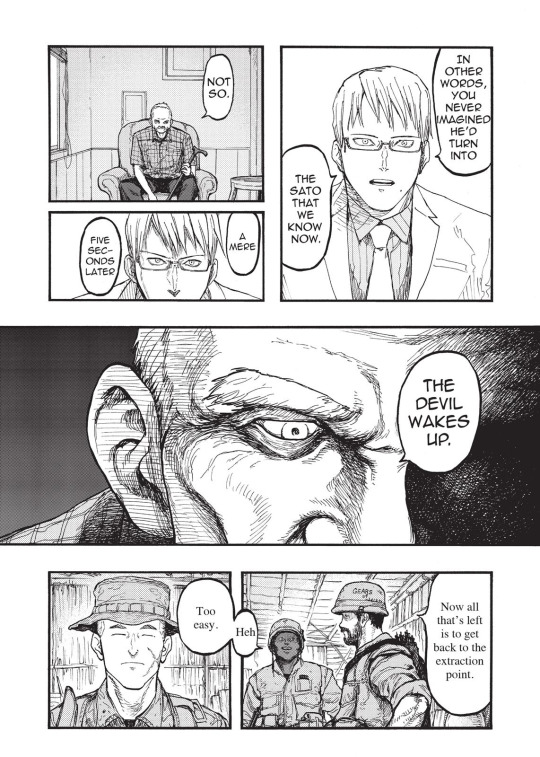
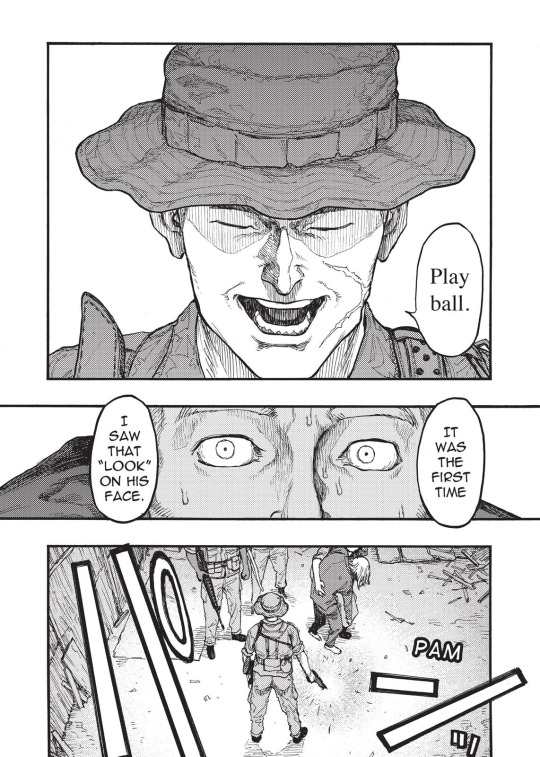

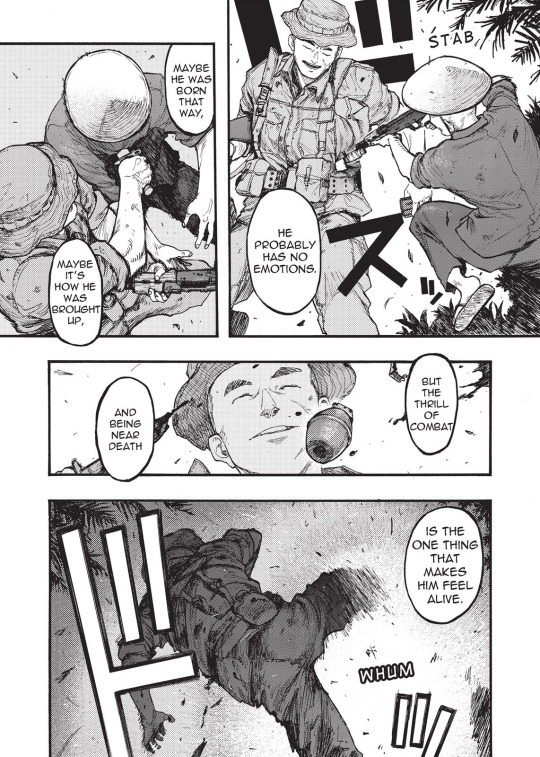
He endangers all of his teammates as well as the rescued prisoner. The stakes that Sakurai has set here, which include multiple lives and Sato's career, encompass the sacrifices Sato will make to entertain himself. As a person, he will readily enter the most dangerous fires if it means he will have fun. Sakurai reiterates my observations with the final pages of chapter thirty, when Sato's dad reprimands him and tells him that life should not be treated as a game, or something trivial and taken lightly.
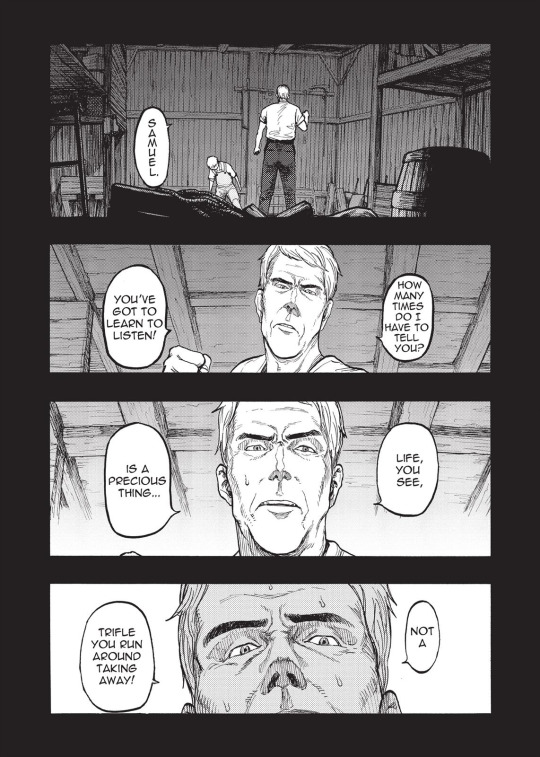
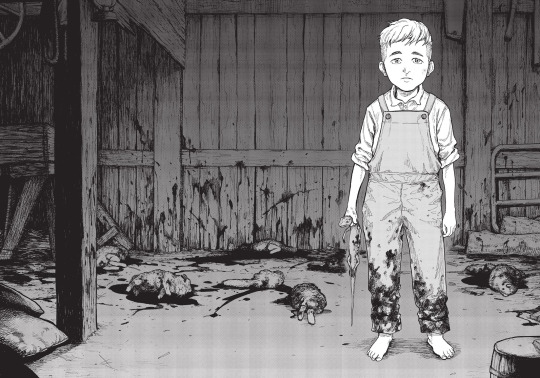
Sato's nature, to see life as a game, and his use of his own and others' to violently entertain himself, leads his motivations throughout the story. I argue that Sato only used the Demi-Human crisis as a conduit for his bloodlust. While such a point seems obvious on the surface, I mean to expel any possibility that he cares even a small bit for Demi-Humans and the growing violence against them. Sato, as a villain, has only one role to play within Ajin: to be the foil of Kei Nagai. Foil here means that both Sato and Kei lack empathy for other people, but they both presents this trait in different ways. Often times, foils are opposite of one another. The narrative focuses around Sakurai's exploration of a moral battle about human empathy. He uses the DH crises as a backdrop of the moral battle occurring between the two. Therefore, I argue that Sakurai uses Sato and Kei Nagai to demonstrate how human rights crises can often be used as covers for battles between powerful individuals' egos.
Throughout the narrative, Sakurai places the general public and the government's focus directly on the Demi-Human humanitarian crisis in Japan. Journalists and political activists argue about the violent extent of anti-DH laws. In online forums, regular people react to the news and viral videos about DHs; some joke, but most refute the idea that DHs face any sort of violence while within government custody. Actual government officials take Sato at face value and argue to ignore Sato's demands and focus on continuing their cruel behavior. The government then aims to more harshly punish and violate DHs in reaction to Sato's crimes and demands.
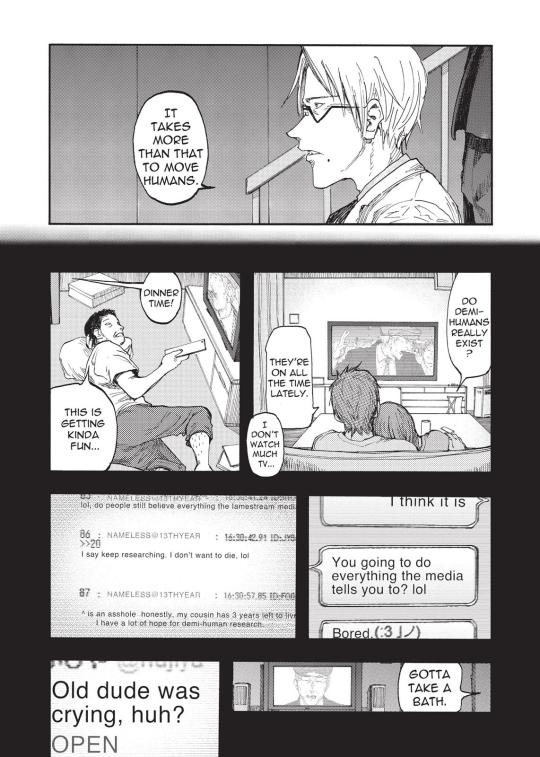


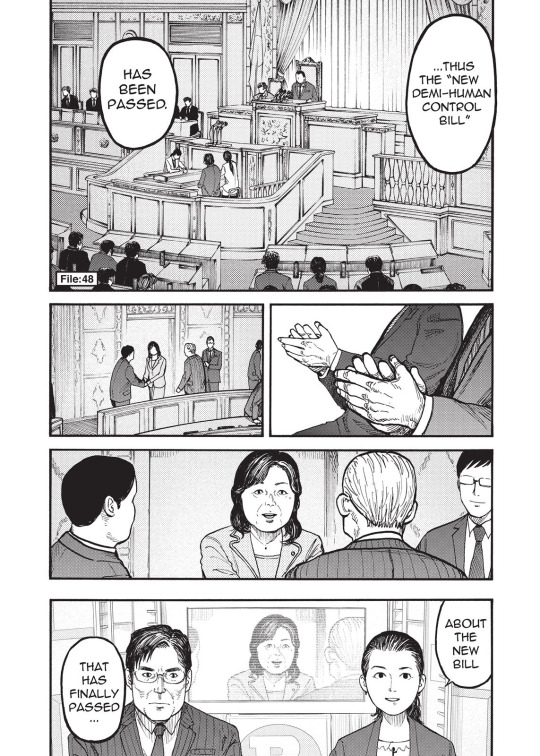

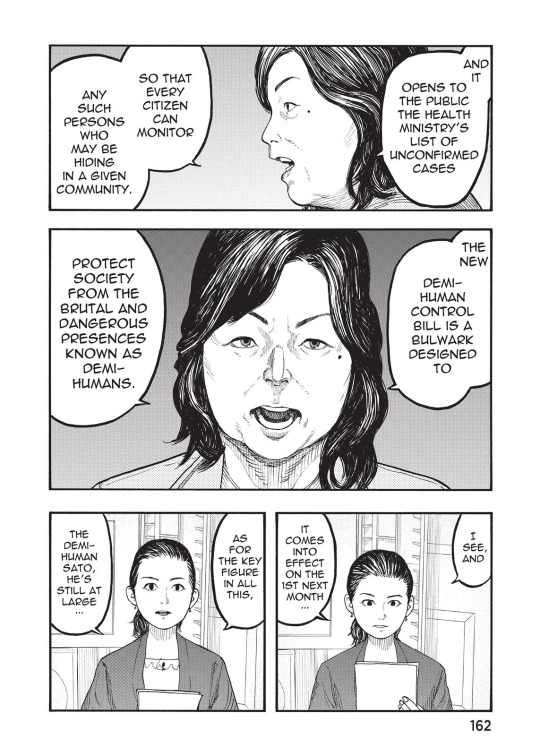
Through pages such as the ones provided, Sakurai demonstrates that Sato nor Kei act as the government and public's main concerns. Instead, Sato nearly single-handedly fuels Japan's arguments and attitudes about the DHs. Sato's claims of the government torturing DHs, his terrorist attacks, and his online uploads only inspire Japan to focus on DHs, not himself, as a subject of discussion. The discourse hinges on the questions: what does Japan do about the DHs?; are they allowed to live fulfilling lives?; should the government more viciously hunt DHs down? Sakurai depicts a Japan that says yes. The DH Control Bill represents an oppressive government's readiness to punish all those who they feel do not belong in their society. Sakurai also heavily criticizes governments' ties to corporations and the greed that prospers between these institutions. While the government denies that DHs were ever tortured, they also expeditiously pass laws that punish any and all DHs in reaction to one person's terrorism.
Despite his blatant commentary on the ways a society can trample on the human rights of oppressed groups, Sakurai focuses Ajin's narrative on Sato and Kei more than anything. All the details expressed above occur in the background of the narrative.
Japan denies that a DH human rights violation has occurred, while simultaneously denying DHs humanism. Throughout the narrative, the government takes egregious actions against DHs. Sakurai rarely shows any DHs beyond the main cast that suffer from these laws. Kei’s death in the first volume and Izumi’s backstory does show the reader the public’s general knowledge that DHs can be turned in for a ransom. Yet, beyond Izumi and Kei, Sakurai does not depict any other DHs fleeing or suffering from the violent laws being passed in the background of the narrative.
Sakurai has no need to show any background stories of DHs suffering. The story focuses on the battle between Sato and Kei most of all. Each story arc revolves around conflict between Sato and Kei. Every other character involved may be seen as simply being collateral damage in the battle between the two of them. Sakurai does not need to depict any other DHs suffering from the aggressive and violent laws made to oppress them, because that's not the point. Sakurai purposely depicts a society caught in the midst of an ego battle between two people. Chapter thirty-one begins with a neat illustration of my argument. The DH rights crisis appears in the literal middle of illustrations of Kei and Sato's battle of egos.
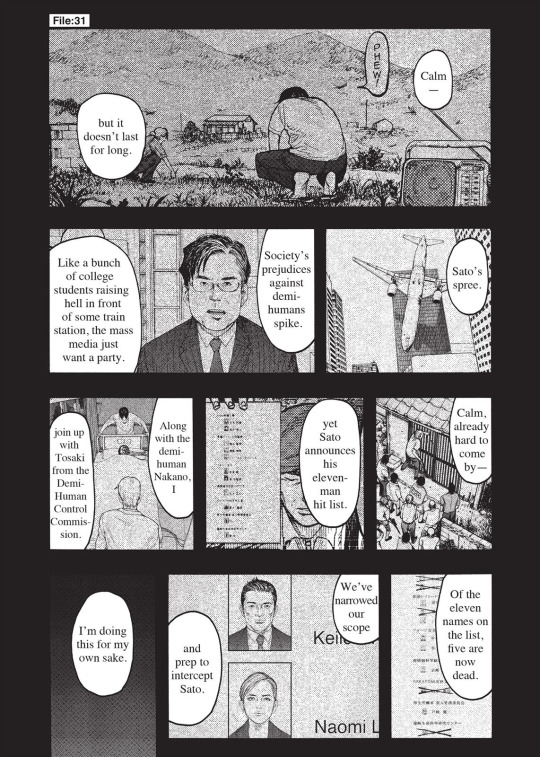
Sato's terrorist attacks act as nothing more than extensions of his own ego. As argued above, Sato does not care even a little about DH rights. He uses the DH humanitarian issue as a catalyst to fuel his need for bloody entertainment. Sakurai overtly depicts Sato as a character with no regard to the importance of life at any capacity.
Sato's bloodthirst and role as an aggravator for a humanitarian crises sets him up to be a morally bankrupt symbol of militaristic power. He pretends to act in the interest of an oppressed minority group while actually only satisfying his bloodlust. Sato's defeat therefore represents a victory in favor of the defense of life and its importance. Also, an expulsion of false actors in the fight for oppressed peoples' freedom from oppressive governments. More on the implications of Sakurai's ending later.
Sakurai uses Kei to depict his idea of what a struggle between an emotional and purely "rational/logical" perspective of the world looks like. I place rational and logical in quotations because even in-narrative, this terms takes on different meanings. At one point, a rational decision means acting in one's most favorable odds of success. In another moment, Kei breaks this rule and declares it to mean acting in a way to gain more favorable odds for one's goals. Instead, I will refer to the "logical" side of Kei as lacking empathy, because that's what Kei's attitude actually demonstrates.
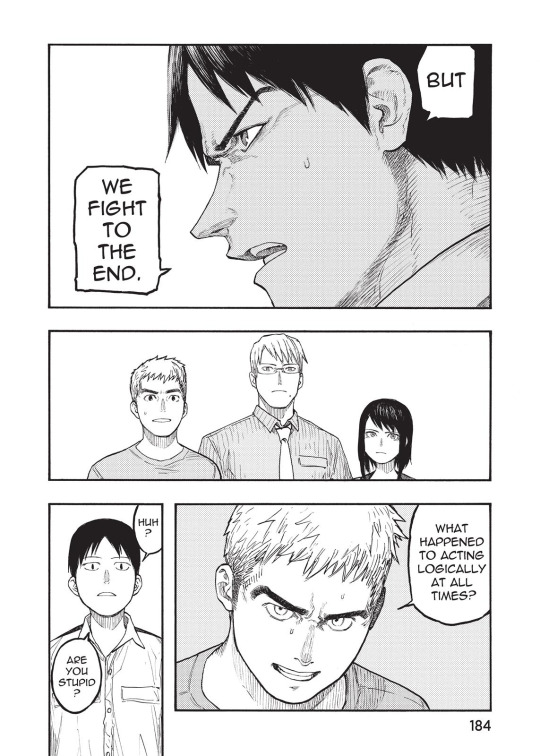
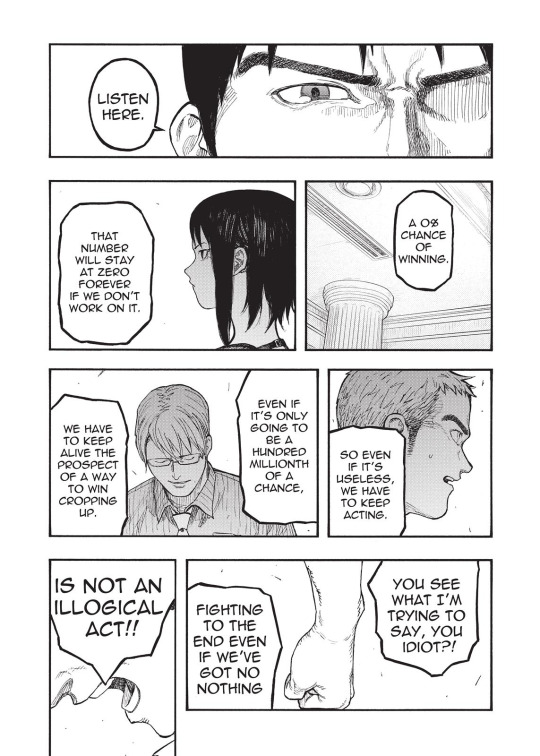

Kei wants to be cold and distant. He feels life would be easier if he could be aloof and above any emotional issues that naturally occur in relationships with other people. He pretends to be above emotional responses to other's pain. In a way, Nakano acts as Kei's foil just as much as Sato. If Sato represents Kei's inability to completely detach himself from his natural empathy, Nakano represents Kei's inability to fully tap into his those feelings. While Kei lacks empathy, he does not see life as a game like Sato does. Kei still believes in an inherent value in life or being alive. Kei still goes out of his way to help others, even when it inconveniences him and his plans. For example, Kei returns to save the grandma who he stayed with, even though he was ready to escape with Nakano and leave the countryside behind. He refuses to explain his actions to Nakano, or even show himself to the grandma, revealing the selfness nature that he shares with Nakano.



Nakano consistently commits to selfless acts in the name of simply helping people. He expects nothing in return for his deeds, nor does he ever express a desire to be seen as a hero. Nakano cries for the sake of the others who have died, and who will die, declaring that he will always give his life to those who need him, no matter what.
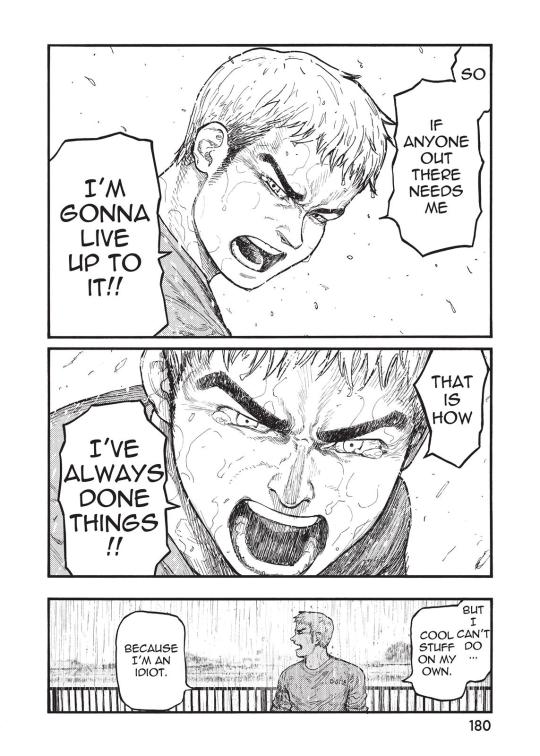
Nakano represents Sakurai's idea of an extreme empathy for other people. He seriously considered Sato's proposal to improve the lives of other DHs, and once that was proven false, he committed himself to stopping Sato's terrorism, exemplifying his highly empathetic nature for other humans. Kei rests at the center of extremes that Sato and Nakano represent. Sakurai uses Kei's mother to demonstrate Kei's personal conflict between a cold demeaner and empathetic reasonings. In the second panel in page twenty-eight, Kei's mother even directly rebuffs Nakano's desire to care for everyone. Sakurai purposely places Kei in the middle of Sato and Nakano's empathetic extremes.
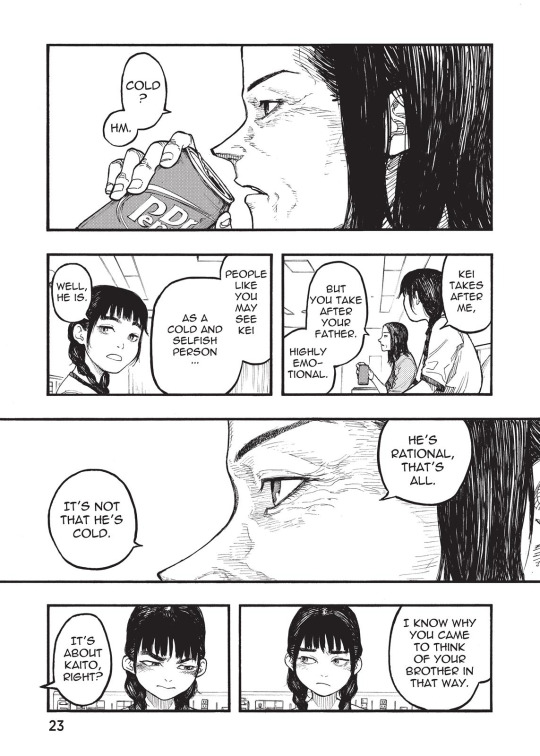

Instead of focusing on Kei as Sakurai's exploration of a balanced moral code, I want to shift focus back to Sato's end. I have thus far agued that Sato never cared about any other DH while he committed terrorist attacks. To reiterate my argument, I have shown evidence that Sakurai's depiction of the DH humanitarian issue plays a background role, while Ajin's narrative instead focuses on the battle between Sato and Kei. Sato's attacks only end on one condition: once he gets bored. He does not complete the hit list because he gets bored of it, same with the suicide plane attacks in the last arc. His motivations center around his need for violent entertainment, which Kei's challenges stimulate. In the end, when Sato is stopped, it's only after he's done doing everything he wants. Essentially, Sato does not lose, he simply satisfies himself. He reaches game over of his terrorist attack speedrun.
Sato's self-inflicted game over does not meet the stakes Sakurai set for Sato as a villain. As I argued above, Sato's defeat represented a victory in favor of the defense of life, and an expulsion of false actors in the fight for oppressed minorities against oppressive governments.
Given that Sato represents the worst of humanity, a powerful being with zero empathy for others, I find it distasteful for him to be allowed to commit egregious acts of terrorism on a whim and hardly suffer any consequences. Sato's unconscious body only receives an indefinite prison sentence. Because Kei simply knocked him out, Sakurai alleviates Sato of having to directly face any moral judgements from other characters. The rest of the cast do not get to voice their grievances directly to him. Honestly, it's not like he would care one way or another anyway. Sato reads to me as a power fantasy character. Not to say that he's Sakurai's power fantasy, or a projection. Just that he fits the model of one (extremely capable and undefeatable). Sato doesn't care about laws or consequences of his actions, and instead solely cares about his own entertainment. Not his own well-being, or anyone else's.
Sato allowed Kei to rush him into the river and possibly knock him unconscious. In the end, it was his decision to be caught. He was never defeated. He simply gave Kei the chance to win on the foundation of a desperate wager.
What does it mean for Sakurai to create a story in which the morally bankrupt type of human never loses? Ajin depicts a small group of humans attempting to save Japan from a crazed terrorist desperate to make the entire country his bloody playground. Sato spits in the face of people who genuinely care about the DH crises around the world. Sakurai criticizes Japanese media and government as immoral and corrupt institutions throughout the entire story. Finally, he depicts their violent murders at Sato's hands.
I do not have any extreme take to attach Sato's non-defeat too, and I won't make any wild arguments about Sakurai's politics considering the unserious and exaggerated tone of Ajin. But I will say that as a reader, Sato's non-defeat weakened the story for me. Sato's ending weakens every other character's, especially Kei's. They appear to me as people who luckily maintained some semblance of dignity instead of triumphant warriors who took down a morally bankrupt mastermind who unnecessarily endangered a minority group of humans.
I enjoyed Ajin, but I would not read it again. I personally do not find enjoyment rooting for Sato, but instead against him. When the stakes for his death were so thoroughly raised, Sakurai's decision for Sato to never actually be defeated spoiled those expectations I had for a narrative about the importance of human empathy.
Officially, I give Ajin a 6/10. Hope you enjoyed reading!
#ajin#ajin review#ajin manga#ajin demi human#kei nagai#sato ajin#ko nakano#izumi shimomura#literature review#manga review#gamon sakurai#review
13 notes
·
View notes
Text

Me, when the Literature ain't reviewing...
4 notes
·
View notes